Homepage of the Action, Computation, & Thinking (ACT) Lab, Yale department of psychology
Happy to announce that my lab @ Yale Psychology (actcompthink.org) will be accepting PhD applications this year (for start in Fall '26)!
Come for the fun experiments on human learning, memory, & skilled behavior, stay for the best 🍕 in the US.
Please reach out if you have any questions!
24.07.2025 13:29 — 👍 105 🔁 48 💬 3 📌 0
Excited to see this collaborative work out! A representation of a robotic limb that’s both effector- and controller-independent? We take a deep dive into motor learning generalisation with the Third Thumb. Congrats @mariamolinasan.bsky.social!
🔗 www.biorxiv.org/content/10.1...
08.07.2025 12:20 — 👍 5 🔁 0 💬 1 📌 0
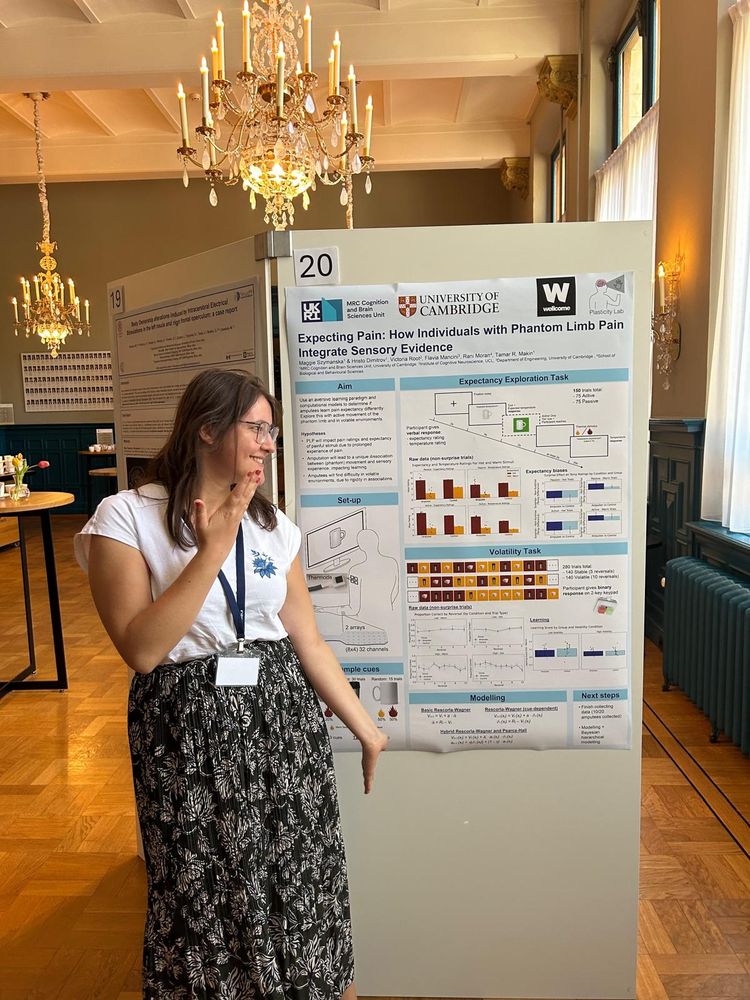
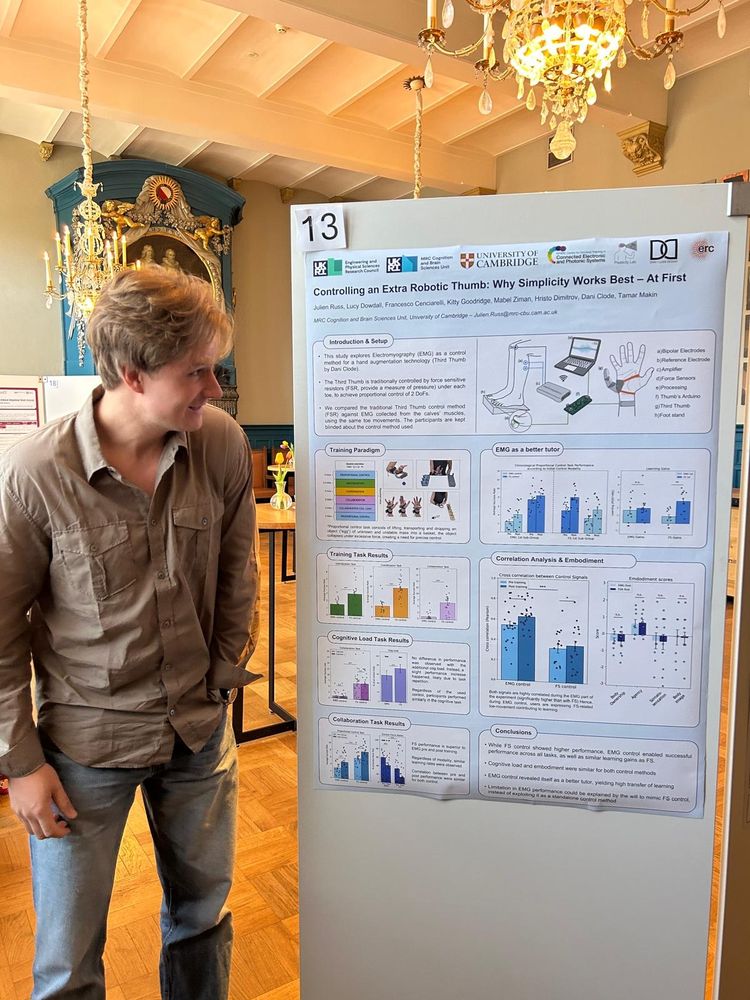
Our PhD students @maggieszymanska.bsky.social and Julien Russ ready to present their posters today at #BRNet2025! Find them in the poster room at 2pm, talking about phantom limb pain and using EMG to control the Third Thumb 🧠
04.07.2025 10:55 — 👍 13 🔁 4 💬 0 📌 1
Catching up with the community at UK Sensorimotor is always a highlight of the year! Thanks for having us @uksensorimotor25.bsky.social @ox.ac.uk !
27.06.2025 13:56 — 👍 1 🔁 0 💬 0 📌 0
Check out the full pre-print now: doi.org/10.1101/2025.06.16.658246. This work was truly a collaborative and interdisciplinary effort, and we’d like to thank all of our collaborators, and the over 100 participants that made this work possible! @plasticity-lab.bsky.social
19.06.2025 13:02 — 👍 2 🔁 1 💬 0 📌 0
Together, these results demonstrate that our somatosensory system can facilitate an immediate and accessible sensory representation of the Third Thumb. This is then refined through experience, allowing integration of the Third Thumb into the hand representation across the sensorimotor hierarchy
19.06.2025 13:02 — 👍 0 🔁 1 💬 1 📌 0
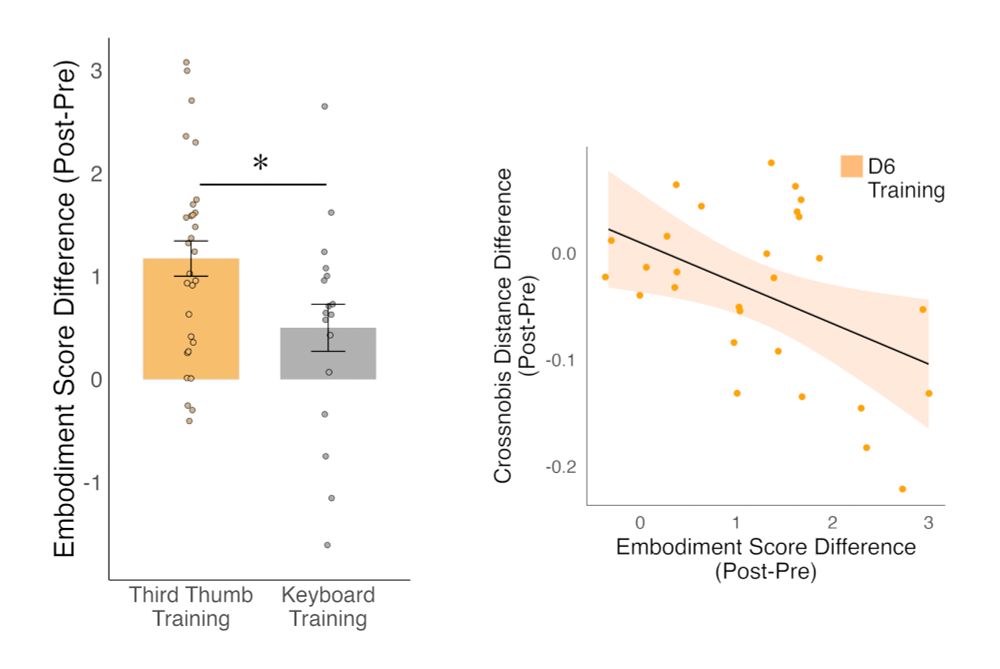
Finally, we not only found increased subjective somatosensory embodiment following Third Thumb training, but this increase also correlated with increased similarity between the Third Thumb and biological fingers in S1
19.06.2025 13:02 — 👍 0 🔁 1 💬 1 📌 0
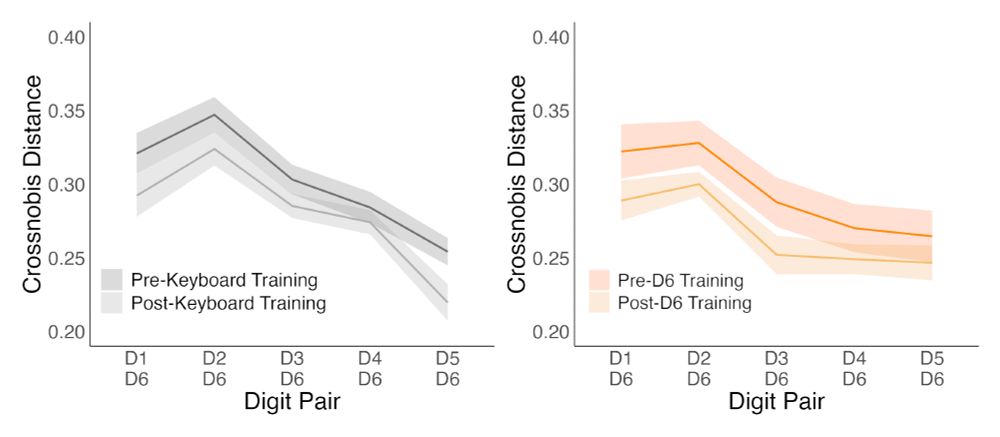
Within the S1 hand representation, we saw experience-dependent refinement of the Third Thumb’s sensory representation following training, as it became more similar to the biological fingers in a way not seen for our control group
19.06.2025 13:02 — 👍 0 🔁 1 💬 1 📌 0
Following Third thumb training, markerless hand tracking revealed reduced co-usage amongst the biological fingers as the Third Thumb became integrated into the hand’s coordination patterns
19.06.2025 13:02 — 👍 0 🔁 1 💬 1 📌 0
To explore how sensorimotor experience refines this representation, participants then underwent 7 days of motor training involving Third Thumb-biological hand collaboration, or our control group instead trained to play the piano keyboard
19.06.2025 13:02 — 👍 0 🔁 1 💬 1 📌 0

Using RSA, we found the immediate emergence of a topographically organised Third Thumb sensory representation within S1. This representation is also distinct from the biological palm representation
19.06.2025 13:02 — 👍 0 🔁 1 💬 2 📌 0
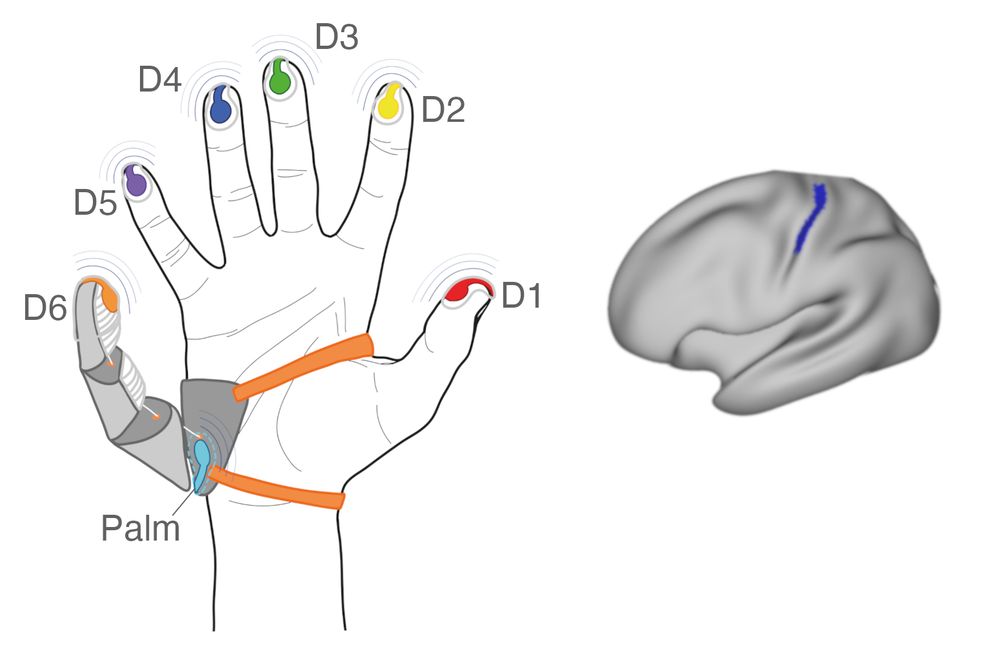
But how does the brain then represent this natural sensory information? We next stimulated the Third Thumb and the biological hand, and used fMRI to map their sensory representations in primary somatosensory cortex
19.06.2025 13:02 — 👍 0 🔁 1 💬 1 📌 0
Despite the tasks being designed for the artificial systems, participants performed equally, or even outperformed, with the natural feedback, demonstrating that meaningful, interpretable information can be extracted from the natural feedback across versatile task demands
19.06.2025 13:02 — 👍 0 🔁 1 💬 1 📌 0

To put this natural feedback to the test, we created 2 new Third Thumb systems - one integrated artificial skin stretch feedback, the other integrated artificial vibrotactile feedback. We then compared the artificial to the 'natural' feedback across perceptual discrimination tasks
19.06.2025 13:02 — 👍 1 🔁 1 💬 1 📌 0

This is possible through the previously neglected role of the ‘natural’ feedback received as a natural by-product of how artificial limbs interface with the biological body. For example, the Third Thumb is worn and moves on the hand, this naturally generates sensory information felt across the palm
19.06.2025 13:02 — 👍 1 🔁 1 💬 1 📌 0
However, despite having no artificial feedback, we have previously demonstrated that people can perform a coordination task with the Third Thumb when blindfolded, relying on a sense of proprioceptive awareness of the robotic digit
19.06.2025 13:02 — 👍 2 🔁 1 💬 1 📌 0
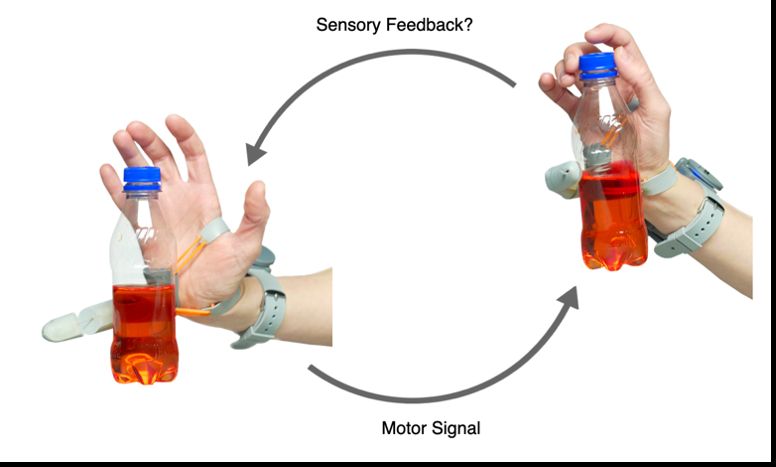
Somatosensory feedback is crucial for motor learning, yet artificial limbs are thought to lack such feedback. Research has therefore focused on creating artificial sensory feedback, but these signals do not replicate the rich, multimodal information available from natural touch-see shorturl.at/2PMyU
19.06.2025 13:02 — 👍 1 🔁 1 💬 1 📌 0
Excited to share our new interdisciplinary work exploring the sensory representation of an artificial body part, combing datasets and methodologies to explore sensorimotor integration of the Third Thumb, a 2 DoF hand augmentation device (@daniclode.bsky.social) doi.org/10.1101/2025.06.16.658246
19.06.2025 13:02 — 👍 119 🔁 26 💬 11 📌 10
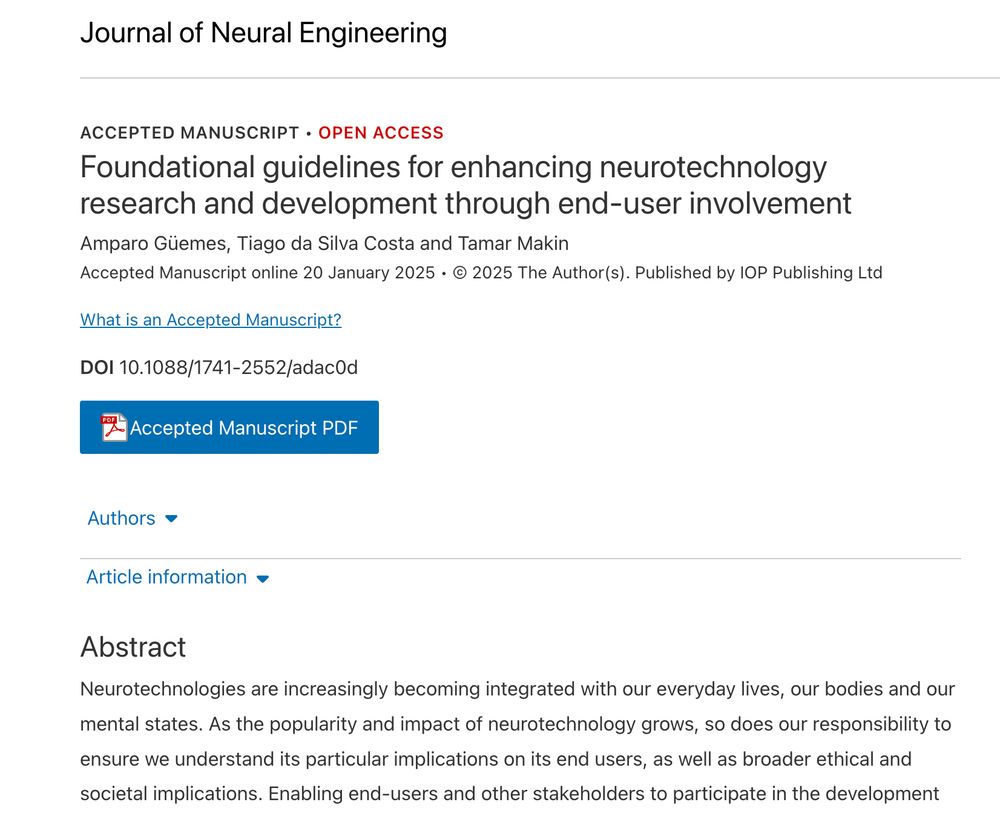
Neurotech is rapidly evolving, but user-centred technologies can only succeed if their development actively involves the end user. We’ve published a basic roadmap for supporting inclusive design testing - highlighting key strategies, stakeholders, representation, and measurable outcomes rb.gy/ng1jus
23.01.2025 19:08 — 👍 4 🔁 2 💬 0 📌 2
New essential reading for anybody working in sensory feedback!
19.12.2024 21:29 — 👍 1 🔁 0 💬 0 📌 0

Now you’ve met the lab, come work with us! We’re hiring a Research Assistant to join the Plasticity lab 🦾 in early 2025 at the MRC Cognition and Brain Sciences Unit, University of Cambridge. Find out more information here: www.jobs.cam.ac.uk/job/49393/. Closing date 8th of January! 🧠
10.12.2024 09:52 — 👍 3 🔁 2 💬 0 📌 2

We’re thrilled to share our new research article, "Shaping the developing homunculus: the roles of deprivation and compensatory behaviour in sensory remapping on bioRxiv: rebrand.ly/qbz6nal with @dorothycowie.bsky.social
09.12.2024 16:47 — 👍 43 🔁 19 💬 1 📌 7
Come meet our lab and find out about our work!
25.11.2024 22:43 — 👍 2 🔁 0 💬 0 📌 0
Professor, Rehab Neural Engineering Labs, University of Pittsburgh
Neuroscientist | Assistant Professor @ucl | Wellcome Trust CDA Research Fellow 🇬🇧| Post-doc: Scanziani lab 🇺🇸 @UCSF | PhD 🇨🇭@FMIscience
Open jobs: www.ruedigerlab.com
The Society for the Neural Control of Movement: Advancing our understanding of how the brain controls movement.
www.ncm-society.org
Cognitive neuroscientist and nature lover. Founding Director of Brain and Mind at Western University. https://www.uwo.ca/bmi/
PhD. Neuroscientist. Professor. Former classical ballerina.
Physical therapist. Postdoctoral research fellow at the Jefferson Moss Rehabilitation Research Institute
Neural Engineering PhD student working on BMIs and FES
Laboratory for Intelligent Machine-Brain Systems (LIMBS)
Case Western Reserve University
Postdoctoral fellow at Artctic University of Norway; formerly MPI CBS, Humboldt, Ghent, and Duke University
External and internal attention; mind wandering; interoception and control over internal body
https://samverschooren.github.io
Assistant Professor at Northumbria University. Studying sex differences in neurophysiology and responses to exercise.
https://scholar.google.co.uk/citations?user=1Z4aCNcAAAAJ&hl=en&oi=ao
From Taiwan
Research Assistant at Plasticity Lab, University of Cambridge.
I’m passionate about sensorimotor control—how we move, feel, and adapt—and leveraging technology to enhance recovery.
Also, a cat and dog lover!
Part-time engineer, part-time neuroscientist
Department of Bioengineering, Imperial College London, UK
https://dyneumo.ic.ac.uk
Ph.D. Candidate at EPFL 🇨🇭, Translational Neural Engineering Lab | Previously at Harvard Medical School | Working on cortical motor control and neural representations 🧠👨🏻💻| Opinions are my own!
PhD Student at the University of Bath | Neuropsychology | Movement Perception and Understanding | Brain Stimulation | Open Science
phd student in compneuro @ sprekeler lab
lisboa / 📍berlin :)
brazilian postdoctoral researcher at RNEL (University of Pittsburgh) focused on spinal neural circuits, motor control and spinal cord stimulation 🏳️🌈 he/him
Assistant Professor and PI at Donders and Karolinska Institutes, leading the Somatosensation&Gargalesis lab (a.k.a Touch&Tickle lab). I study actions, touch, and tickles 🧠 (https://www.kiltenilab.org/). Ελληνίδα that cooks dolmadakia for friends.
We study the sense of self, body representation, and the human brain. Based at Karolinska Institutet, led by Henrik Ehrsson.
Neural engineer: Spinal cord stimulation⚡️, sensorimotor systems, control, rehabilitation🦿👩🦽🚶♀️ Thoughts=mine
Neuroengineer, tactile sensing, prostheses, brain-computer interfaces. Case Western Reserve University.

















